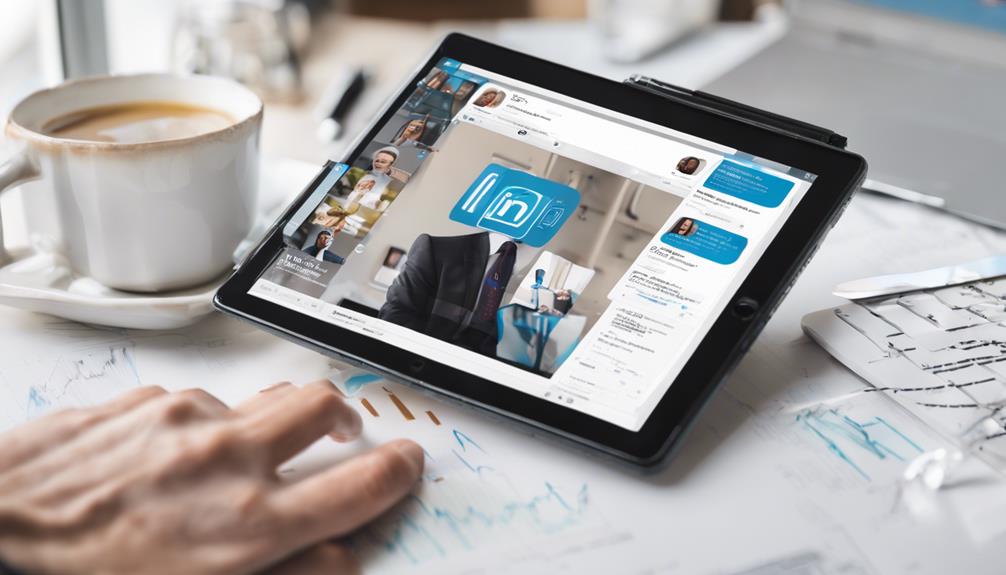
You've likely noticed how your LinkedIn feed fills with a myriad of posts, each vying for your attention. But have you considered the power of your 'Saved Posts' as a window into evolving industry trends? By selectively bookmarking articles, insights, and discussions, you're essentially building a personalized data bank. Analyzing these can reveal not just fleeting fads but substantial shifts in your sector. Imagine identifying a groundbreaking technology trend or a shift in consumer behavior before it becomes mainstream discussion in your network. Curious about how to transform these saved posts into actionable insights? Let's explore some key strategies.
Understanding LinkedIn Saved Posts

LinkedIn's "Saved Posts" feature acts as a personal content library, allowing you to bookmark articles, videos, and other resources that catch your interest. You've likely scrolled through your feed and found insights or data that you couldn't delve into at the moment. With a simple click on the bookmark icon, you can preserve these posts for later review.
This tool is seamlessly integrated within the LinkedIn platform, making it incredibly easy to manage. To access your saved content, you just need to navigate to the "My Items" section found under the "Me" dropdown menu. Here, you'll find your collection of saved posts neatly organized.
Whether you're using LinkedIn on your desktop or mobile, your saved items synchronize across all devices, ensuring you can access them anytime, anywhere. Managing your saved posts is straightforward. You can unsave items with just as much ease as you saved them, keeping your digital space clutter-free.
This feature is particularly useful for ongoing learning and professional development, as it allows you to curate a library tailored to your career interests and needs. So, start saving those posts that resonate with your professional journey!
Importance of Saving Posts
Saving posts on LinkedIn can significantly enhance your learning and information retention. When you save a post, you're not just bookmarking something to look at later; you're strategically setting aside valuable insights that can influence your professional development. It's like creating a personal library of ideas and trends that matter to you.
Think about the whirlwind of information that hits you every day. Without a method to capture the most relevant pieces, it's easy to forget or overlook valuable insights. That's where saving posts becomes crucial. It allows you to curate content that aligns with your career goals and industry changes, making sure you're always a step ahead.
Moreover, revisiting these saved posts can deepen your understanding of complex topics. Each review can reveal new perspectives or reinforce essential concepts, which is vital in keeping your knowledge fresh and applicable.
It's also a fantastic way to prepare for meetings, presentations, or interviews, as you have a ready reservoir of information to tap into.
Types of Posts to Save

Now that you understand the importance of saving posts for your professional growth, let's explore what types of posts you should consider keeping.
First, think about industry updates. These can be posts that detail emerging trends or new technologies reshaping your field. Saving these allows you to stay informed and ahead in your industry.
Next, focus on thought leadership articles. Leaders and innovators often share valuable insights on LinkedIn. Their posts can provide you with new perspectives or strategies that can enhance your professional approach.
Don't overlook practical tips and tutorials. Whether it's a quick productivity hack or a detailed guide on using a new tool, these posts are goldmines for improving your skills. They're not just informative; they're directly applicable to your daily tasks.
Also, consider saving case studies and success stories. These not only motivate but also show real-world applications of theories and strategies. They can serve as excellent reference points for your projects or presentations.
Lastly, keep an eye out for posts announcing webinars and workshops. These events are opportunities for learning and networking. By saving these posts, you ensure that you don't miss out on valuable educational sessions.
Organizing Saved Posts
After you've compiled a robust collection of saved posts, it's crucial to organize them effectively to maximize their utility. Start by categorizing your saved items into clearly defined folders. You might label them based on topics like "Innovation," "Leadership," or more specific subjects relevant to your industry. This step ensures you can access the right content quickly when you need insights or inspiration.
Next, consider the frequency of review. Set a regular schedule, maybe once a week, to go through your saved posts. This habit not only keeps your collection manageable but also keeps the information fresh in your mind. Use this time to discard posts that are no longer relevant or have become outdated, ensuring your resources remain valuable and current.
Additionally, leverage tools that facilitate organization. Many platforms offer tagging features, allowing you to add keywords to each post. Tags can be incredibly helpful when you're searching for specific themes or ideas within your collection.
Analyzing Content Themes

Once your saved posts are neatly organized, you can begin to analyze the content themes effectively. This process involves digging deeper into the types of content that consistently catch your eye. Are you drawn to innovative tech developments or leadership strategies? Maybe you're saving more posts about sustainability in business. Recognizing these patterns isn't just about understanding your interests—it's about pinpointing what matters most in your industry.
Start by categorizing these posts. You might label them under technology, leadership, marketing, etc. This segmentation will help you see which topics are getting more traction and which are underrepresented. It's crucial to note the frequency of themes. If you're seeing a surge in posts about remote work solutions, it's not just popular; it's becoming a staple.
Next, look at the types of content—articles, infographics, video talks. What format is most common? This isn't about preference but about effectiveness. Which format best delivers the message?
Identifying Emerging Trends
As you delve into the themes you've categorized, you'll start noticing patterns that point to emerging trends within your industry. These patterns often reflect shifts in technology, customer preferences, or even regulatory changes that could significantly impact how businesses operate.
It's vital to track these evolving trends to stay ahead.
You'll see certain topics gaining traction through increased mentions and discussions. For instance, if you're in the tech industry and notice a surge in posts about artificial intelligence in healthcare, this could indicate a trend towards more AI integration in that sector.
Pay attention to who's sharing these insights as well—industry leaders or influencers discussing specific themes can validate their importance and influence.
Look for overlaps in content themes across different sectors too. These intersections are often breeding grounds for innovative ideas and can lead to cross-industry collaborations.
By monitoring these patterns, you can anticipate changes and position yourself as a forward thinker in your field.
Tools for Trend Analysis

To effectively track and analyze these emerging trends, you'll need robust tools designed specifically for trend analysis. Leveraging these tools, you can sift through vast amounts of data from LinkedIn posts and beyond, pinpointing exactly what's catching the industry's attention.
First up, consider utilizing advanced analytics platforms like Tableau or Power BI. These tools help you visualize data trends in real-time, allowing you to see how certain topics gain or lose traction over time. They're indispensable for spotting patterns that mightn't be obvious at first glance.
Next, you can't overlook the power of social listening tools such as Brandwatch or BuzzSumo. These applications scan social media platforms, including LinkedIn, to track mentions of specific keywords or topics. They offer insights into how frequently and in what context these terms are being discussed, providing a clear picture of their popularity and relevance.
Case Studies and Examples
By examining real-world applications, we can see how effectively these tools predict and influence market trends.
Take, for instance, the fashion industry, where trend prediction tools sourced from LinkedIn's saved posts have revolutionized how brands forecast and respond to the next big thing. You've probably noticed how quickly a new style can go from runway to retail these days. That's no coincidence. Analysts track designers and influencers on LinkedIn, analyzing their saved posts to gauge upcoming trends, which in turn allows companies to adjust their strategies in near real-time.
Consider also the tech sector. A tech firm noticed a surge in posts related to artificial intelligence on LinkedIn, which they interpreted as an emerging trend. By aligning their product development to include AI enhancements earlier than competitors, they gained a significant market advantage.
These examples illustrate not just the predictive power of analyzing LinkedIn data but also how such insights directly influence business strategies and outcomes.
It's clear that staying ahead in today's fast-paced market environment isn't just about having access to data—it's about quickly translating that data into actionable strategies.
Applying Insights Strategically

Understanding how to strategically apply insights from industry trend data can significantly enhance your competitive edge. As you navigate through the vast sea of information available, pinpointing actionable insights is crucial. You'll want to focus on trends that align with your strategic goals and can realistically be integrated into your business operations.
Start by identifying patterns in the data that reveal emerging market needs or shifts in consumer behavior. This isn't just about spotting what's new; it's about recognizing the trends that will drive future growth. Ask yourself, how can these insights lead to innovative products or improve your services? For instance, if you notice an uptick in remote work tools, consider how your business could adapt or expand its offerings in this area.
Next, prioritize these insights based on potential impact and feasibility. It's tempting to jump on every trend, but you must be selective. Implement changes that offer the most significant benefit and are manageable within your current resources.
Frequently Asked Questions
How Can Linkedin Saved Posts Improve Personal Branding?
By curating LinkedIn saved posts that align with your expertise, you're able to showcase your professional interests and knowledge, enhancing your personal brand and making you more attractive to potential employers and collaborators.
Can Saving Posts Influence Linkedin Algorithm Visibility?
Yes, saving posts can influence your visibility on LinkedIn's algorithm. It signals your interests and engagement, potentially boosting your profile in relevant feeds, thus enhancing your online presence and connectivity opportunities.
Are There Privacy Settings for Linkedin Saved Posts?
Yes, you've got privacy settings for LinkedIn saved posts. They're only visible to you, so no one else can see what you've saved. This keeps your interest areas private and secure.
How Often Should I Review My Linkedin Saved Posts?
You should review your LinkedIn saved posts at least once a month to ensure they're still relevant and to keep up with any updates or changes in the information or contacts they contain.
Can I Share My Collection of Saved Posts With Others?
Yes, you can share your collection of saved posts with others. Just select the post you want to share and use the share feature to send it directly or post it publicly on your profile.
Conclusion
Now that you've mastered using LinkedIn Saved Posts to decode industry trends, start applying these insights strategically. Save posts that ignite ideas and organize them effectively. Analyze their themes to spot emerging trends and use the right tools to deepen your understanding. Remember, the knowledge you gain will give you a competitive edge. So keep adapting, keep learning, and use what you discover to make informed, strategic decisions that propel your career or business forward.






